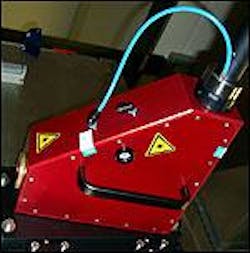A start-up company in England has taken laser technology developed for industrial cleaning and applied it to the task of removing leaves that create a perennial hazard on railway lines. LaserThor (Hampshire, England) uses a trainborne system based on an Nd:YAG laser to ablate leaf debris from rails. The company believes that the system can remove other track contaminants, such as oil, grease and rust.
Each autumn brings problems with leaves on railway lines. Many lines have trees growing close by, and trees are sometimes planted close to the railway in order to cut down train noise. When the leaves fall, the problems start. Leaves can be swept up by the turbulence caused by passing trains and then compacted under the wheels of the carriages. The crushed leaves form a hard, black, shiny substance that is difficult to remove from the tracks. When this layer becomes wet it is extremely slippery and the reduced adhesion between wheel and track makes it difficult for trains to slow down and stop. Under these conditions some trains need twice the usual distance to come to a halt. Leaves on the line also affect remote signaling systems, providing another hazard. The rail operators and their customers suffer delays and cancellations each year. Until now, the only solution has been to transport an army of workers around the country to clean the rails in the early hours of the morning, blasting and scouring the tracks by hand.
The time is clearly ripe for a higher-tech solution, which is evident from the support the new company has received from rail operators in England. LaserThor was founded in November 1999 by former Royal Navy officer Malcolm Higgins, and the company has made patent applications covering the process in England and selected countries around the world. Know-how has been supplied by the Rutherford Appleton Laboratory (RAL; Abingdon, England) which has been involved in industrial cleaning projects. Start-up and second-round funding have been provided by The Council for the Central Laboratory of the Research Councils (CCLRC), part of the U.K. Department of Trade and Industry and the body that runs the RAL, along with private investors and with the help of government awards.
LaserThor undertook an initial trial in autumn 2000 with an Nd:YAG laser operating at 1064 nm and a rugged mirror system to direct the light onto the tracks. The intense laser pulses ablate the compacted leaf residue off the rails, leaving a clean track and restoring adhesion between wheel and track. In these trials, the company demonstrated that it was feasible to use lasers to remove rail contamination at train speeds of about 8 km/h.
Ablating at high speed
Although successful, the system needed to be able to operate at higher train speeds to be usable as a tool on the rail network. LaserThor began investigating how to make a laser system work with trains running at more realistic speeds of about 70 km/h. A new laser was designed for the application by a team at the Fraunhofer Institute for Laser Technology (ILT; Aachen, Germany). To ablate the leaf contaminant, a laser with high energy in short pulses is needed, which had been provided in the first system but with a relatively low repetition rate. The ILT-designed diode-pumped Nd:YAG laser operates at a 25-kHz repetition rate, with 80-ns pulses each with a peak power of approximately 400 kW. The 1-kW-average-power laser can be fitted into a 1-m3 box, is self-contained, and is engineered for the rigors of train travel. Light from the new laser is delivered to the track via optical fibers. The system was used in successful trials last autumn.
For an industrial application such as this, safety issues also had to be considered. Metallurgical tests have shown that the laser treatment does not damage the track. Environmental tests have shown that the laser ablation process does not produce any harmful emissions. The laser system is shielded and interlocked so that it can be operated safely.
The company is gearing up for live demonstrations to potential customers this autumn, and hopes to sell the first units next year. Tests have shown that the LaserThor system can remove oil, grease, ice, tire rubber, and other contaminants from tracks, as well as leaf debris. Higgins estimates the market may reach 500 units in the first five years, looking at export as well as home markets. As yet there are no competitors.
